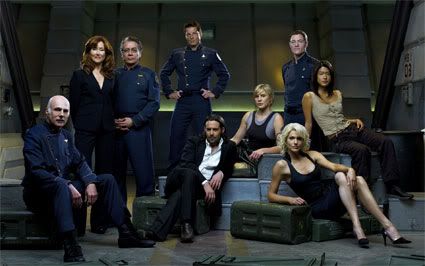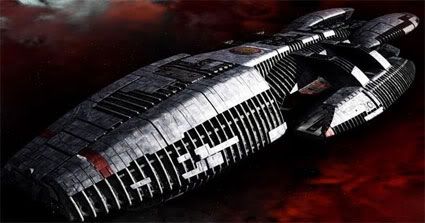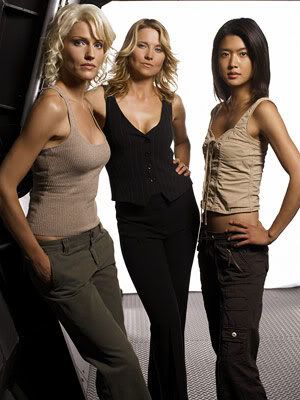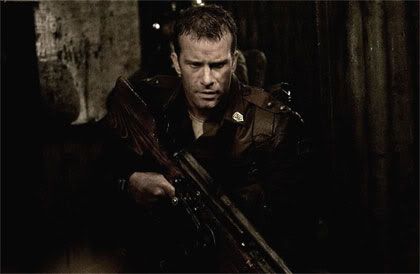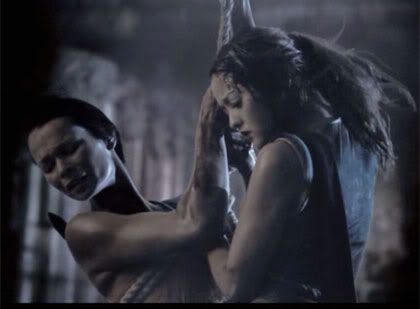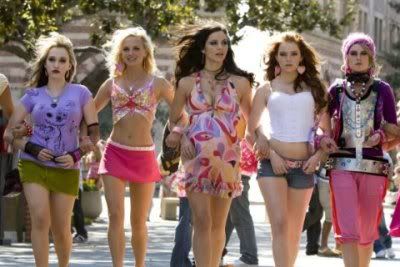
[audio:http://www.blueinkalchemy.com/uploads/terminator.mp3]
Now that the latest film is available on Netflix, as well as the television series, I’d like to discuss the rise and fall of the Terminator franchise. Examining what worked in the various stories of this mythos and where things went a bit wrong, or a lot wrong, should only take a few minutes. It’s interesting, at least to me, that such examinations don’t happen more often when these stories are getting put together. Then again, calling what happens in “Salvation” an actual story is giving it a great deal of credit. Come along, you’ll see what I mean.
The Terminator
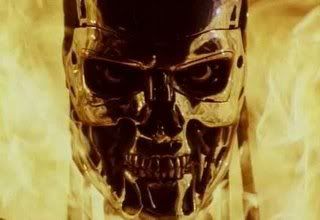
I’ve known grown men haunted by this.
Men in action films were being called ‘killing machines’ before this one came along. Charles Bronson springs to mind. However, James Cameron gave us a literal killing machine. The titular character is a cybernetic assassin sent back in time to murder someone. This target isn’t a genius, or a great warrior or even all that significant. Sarah Connor is a waitress in her late teens who is unaware that she’s in any sort of danger until everybody who has her name starts dropping dead in very violent ways. The only man who can save her, who is even aware of what this killing machine really is, comes from the future and explains why she’s wanted dead: she will give birth to mankind’s best hope for survival in a future where machines are systematically exterminating our race. To prevent John Connor from taking charge of the resistance, the artificial intelligence called SkyNet sent the Terminator to kill his mother before he was even born.
Beyond the action sequences and some high octane nightmare fuel in the form of the skinless Terminator rising from the flames of a wrecked fuel truck, the storytelling’s very tight and the conceptualized time travel is realized rather well. The human characters show depth and real emotion, and Arnold’s star-making role relies on him simply being large and stoic, seemingly unstoppable in his cold rampage. I think a lot of this is actually due to the constraints of the technology of the day. Without CGI or today’s massive effects budget, James Cameron had to use the genius of Stan Winston sparingly. The scene where the Terminator repairs himself is a great example of this. Without a single word and minimal music, Arnold’s actions and the use of a very complex artificial stand-in creates a scene that is both awesome in its execution and squick-worthy in its content. Not only did this film really launch Arnold’s career, it cemented Cameron’s place as the arguable master of the genre.
Terminator 2: Judgement Day
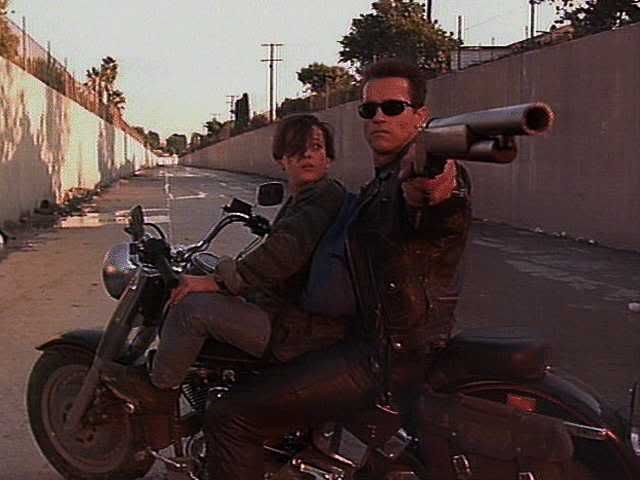
Look up ‘badass’ in the dictionary. You’ll find this.
Sequels can be dubious creatures. It’s rare for a sequel to not only harken back to feelings created by the original, but also build upon the characters, themes and stories established previously. Star Trek II: The Wrath of Khan and The Dark Knight are often mentioned in the same breath as this film, in that they do exactly what a sequel should: taking favorite characters and interesting stories and improving on the overall formula. In this, John Connor’s grown into a somewhat precocious and arrogant pre-teen while his mom has been locked up for trying to tell people about killing machines coming back in time to kill her. A new Terminator, the T-1000, is sent back in time to murder John as a child, while John’s future self captures and reprograms an older model and sends it back as a protector.
Everything that made the first film work is here. However, a lot of concepts are taken in new directions or even turned on their heads. Sarah Connor, learning the identity of the man responsible for creating SkyNet, takes it upon herself to go assassinate him, in effect becoming no better than the machines sent to kill her and her son. The T-800, Arnold’s model, begins to explore the nature of humanity as he spends time with the Connors, and John, who begins the movie zipping around on a dirt bike as he hacks ATMs for cash, turns out to be one of the most virtuous and downright heroic characters in the story. And as for nightmare fuel, the vision Sarah has of the nuclear holocaust that is Judgement Day is as realistic as it is chilling. The action is balanced with humor, the horror with good writing & acting, all coming together in a package that actually outstrips the original. Finally there’s the awesome factor of Arnold hefting a minigun with a little smile on his face, tiny little Robert Patrick tossing Arnold around like a rag doll and Linda Hamilton going completely Amazonian and nearly taking down the T-1000 single-handedly while only having the use of one arm. It gave a fantastic movie-going experience and hope that this trend would continue.
Terminator 3: Rise of the Machines
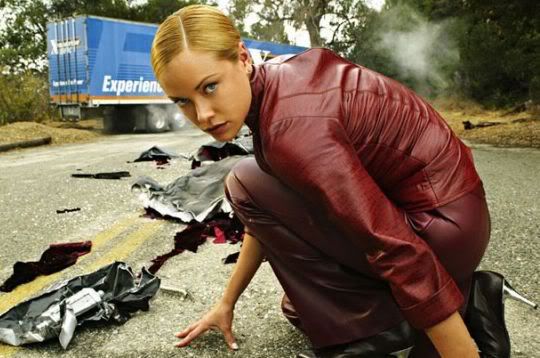
Yeah, she’s kinda hot, but not quite right for a Terminatrix.
It’s unfortunately at this point that the Terminator films began to follow the ways of other sequels: rehashing old ideas while not presenting anything terribly new. John Connor, now a young adult and getting by off the grid after the death of his mother, is once again targeted for termination, this time by a female Terminator with highly advanced weaponry and programming under the liquid-metal skin that made the T-1000 so dangerous. Another older model is sent back to protect him. This time, however, Judgement Day’s coming is inevitable, and John ends up in a bunker with his future wife and becomes the voice of the resistance even as SkyNet brings humanity to its knees.
Instead of doing anything new with the storylines or characters, Terminator 3 suffers from being, in essence, a carbon copy of Terminator 2. The Arnie model is already programmed with psychology so there’s nothing for it to learn, the T-X is somehow less menacing since it has an endoskeleton that can be destroyed as an excuse to have energy weapons in the past, there’s no Sarah Connor against which to contrast John and some of the very rules of time travel are ignored for the sake of plot convenience. Still, it’s difficult for me to confidently say that T3 is a horrible movie since some of it does work, if only because it was looking over the shoulder of T2 and jotting down notes. It’s just shallower than the first two films, and while it does offer the eye candy of Kristanna Loken and some amusing moments like the contents of Sarah Connor’s coffin, it can safely be ignored.
Terminator: The Sarah Connor Chronicles

That’s more like it.
That’s exactly what television producers did when they began the Sarah Connor Chronicles. Taking place after T2, Sarah and John stay on the run until a Terminatrix named Cameron appears from the future to help prevent Judgement Day. As the series goes on, the protagonists move into roles of anti-heroes and even terrorists, breaking the law on a regular basis and pushing the envelope in terms of acts committed for the sake of a greater good. The show grew a very dark and edgy beard, and in my opinion, was too good a show for FOX execs to allow to live.
Aside from casting the always delightful and poignant Summer Glau as Cameron, what this show does right among other things is the dynamic of Sarah and John. In T2 we observe that Sarah loves her son enough to go to murderous lengths to protect him, while John loves his mother too much to see her become a complete monster in the name of his safety. The TV series builds on this, showing Sarah struggling to maintain her humanity in the face of everything she has to do while John slowly has to let go of his young idealism and taking on the mantle of leadership. It is, like the first two movies, smartly written and well acted. And then there’s the fan service – dear God, the fan service.
Terminator: Salvation
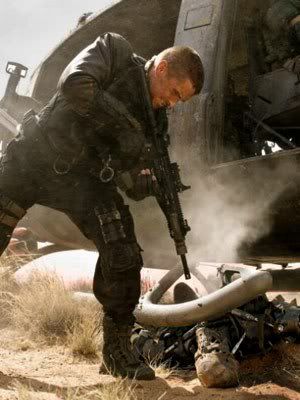
An action shot from
Reversing the way the TV series handwaved T3, the fourth film follows T3’s take on the story and brings us to 2018 where John Connor is not the leader of the resistance, but rather a subordinate officer whom some people (especially those in charge) deem unpredictable or even unstable due to his claims of his own importance. His cell is infiltrated by an advanced prototype Terminator calling itself Marcus Wright, who believes he’s still human, while trying to save a young warrior named Kyle Reese from termination – and thus becoming the cause for his own conception.
I’ve reviewed this film already so let me just briefly cover the bullet points. The writers and director water down the concepts even further from T3 until it feels more like a generic CG-driven action flick than an heir to the Terminator legacy. While Anton Yelchin does very well as Kyle Reese, and Sam Worthington brings a lot of humanity to his character in the face of a lot of alpha-male swaggering, the whole thing overall just feels more empty and lifeless than the machines themselves. Again, there’s some parts of the film that work while others fall flat, so I can’t really call it a horrible movie but it’s really not something I’m interested in watching again, either. But there’s not a great deal of story here, and the emphasis seems more on the action scenes and big robots with lasers.
That, I think, is the failing of the second pair of films. The humanity of the characters is somewhat dialed down so the cool factor of the robots, gunplay and visuals can be turned up. But what worked in the first two films weren’t just the special effects or the action or the bloodshed. It was the characters, very human and well-realized characters, that drove both the plots and the success of those films. Even the television series, blasted by some as being too cerebral or too dark or too God-awful, managed to get that right, focusing on Sarah and John more than it did on killer robots, laser beams and things that belong more in a Michael Bay flick than it does in something that’s actually got a brain in its head.
So, in conclusion, I recommend you watch the first two Terminator films, and if you find yourself hungry for more, check out The Sarah Connor Chronicles. You can watch the other two films if you want, but I feel they’re pretty weak by comparison. Feel free to disagree, though. It’s not like I’ll be able to send a killer cyborg back in time to kill your parents or anythig. Well, not until I figure out what exactly they’re using to power Dick Cheney.
Josh Loomis can’t always make it to the local megaplex, and thus must turn to alternative forms of cinematic entertainment. There might not be overpriced soda pop & over-buttered popcorn, and it’s unclear if this week’s film came in the mail or was delivered via the dark & mysterious tubes of the Internet. Only one thing is certain… IT CAME FROM NETFLIX.

